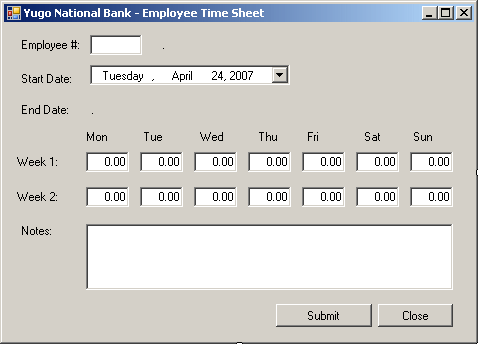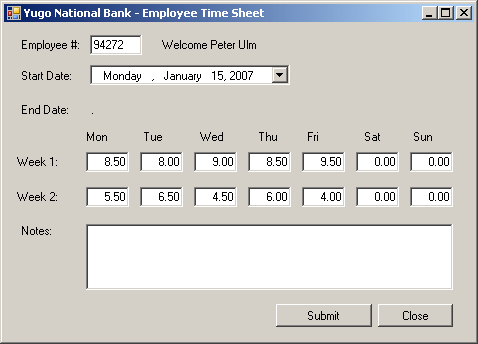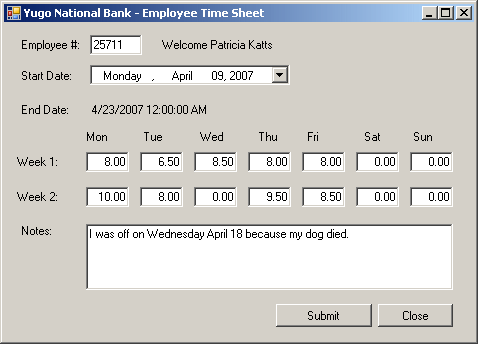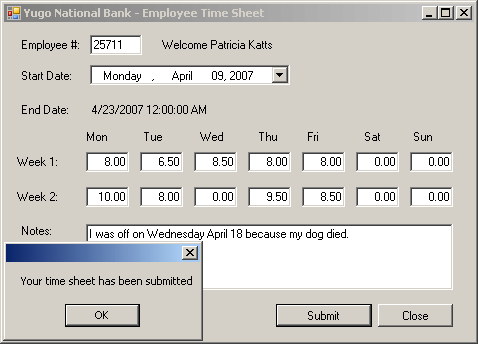|
A
paper time sheet is a physical list of values on a piece of paper. An employee
would usually keep the paper that he or she can pick up at any time and
modify it various times during the time period. If people from the accounting
or payroll department wants to examine the time sheet of one particular
employee, they would have to call the employee and request it. This is can
be difficult or problematic if the employee and the company's accounting are not
physically close, which is not uncommon nowadays (it is not surprising anymore for somebody
located in New York to work for an employer who resides in San Francisco, or for
a contractor in Adelaide to work for a company in Sydney). When the time period
is over, such as at the end of the week or at the end of the two-week period,
the employee can submit the time sheet. The time sheet is then sent to the accounting or
payroll department.
An electronic time sheet is accessed using a computer.
Usually, all employees time sheets are stored somewhere in a database on a
computer. As stated earlier, an employee can access it any time, so can the
accounting or payroll department. This means that, at any time, a supervisor can
check the time sheet, for any reason. To make this possible, an application,
namely a database is created, stored somewhere in a common computer such as a
server, and given access to those who
can use it.
One of the advantages of using paper time sheet
is that, since the employee keeps the time sheet, there is no risk of having a
duplicate time sheet. On the other hand, if you create an electronic table of time sheets,
when an employee who wants to fill out his or her time sheet opens it, you need
to make sure that the right time sheet is opened. In the same way, if somebody
from the payroll department wants to check one particular employee's time sheet,
you need to make it possible and easy to locate the right time sheet.
In the solution we are going to apply, we will create a table of employees and
the time sheet they can fill out. In our time sheet, we will create a certain
column, named TimeSheetCode, that will hold a unique number. We will come back
to the role of this column.
|
 Practical Learning: Introducing the Time Sheet Practical Learning: Introducing the Time Sheet
|
| |
- If you want to practice with this exercise, start Microsoft SQL Server
with the SQL Server Management Studio and connect to the server
- On the main menu, click File -> New -> Query With Current Connection
and type the following:
-- =============================================
-- Database: ynb1
-- For: Yugo National Bank
-- Author: FunctionX
-- Date Created: Monday 24 April 2007
-- =============================================
USE master
GO
-- Drop the database if it already exists
IF EXISTS (
SELECT name
FROM sys.databases
WHERE name = N'ynb1'
)
DROP DATABASE ynb1
GO
CREATE DATABASE ynb1
GO
-- =========================================
-- Database: ynb1
-- For: Yugo National Bank
-- Table: Employees
-- =========================================
USE ynb1;
GO
IF OBJECT_ID('dbo.Employees', 'U') IS NOT NULL
DROP TABLE dbo.Employees
GO
CREATE TABLE Employees
(
EmployeeID int Identity(1,1) NOT NULL,
EmployeeNumber varchar(20),
FirstName varchar(20) NULL,
LastName varchar(20) NOT NULL,
Title varchar(80) NULL,
HourlySalary smallmoney NULL,
CONSTRAINT PK_Employees PRIMARY KEY (EmployeeID)
);
GO
INSERT INTO Employees(EmployeeNumber, FirstName,
LastName, Title, HourlySalary)
VALUES('88024', 'Matthew',
'Larson', 'Account Manager' , 32.15);
GO
INSERT INTO Employees(EmployeeNumber, FirstName,
LastName, Title, HourlySalary)
VALUES('25711', 'Patricia',
'Katts', 'Regional Manager' , 42.15);
GO
INSERT INTO Employees(EmployeeNumber, FirstName,
LastName, Title, HourlySalary)
VALUES('20410', 'Helene',
'Boileau', 'Cashier' , 12.15);
GO
INSERT INTO Employees(EmployeeNumber, FirstName,
LastName, Title, HourlySalary)
VALUES('91272', 'Peter',
'Ulm', 'Head Cashier' , 22.15);
GO
INSERT INTO Employees(EmployeeNumber, FirstName,
LastName, Title, HourlySalary)
VALUES('29475', 'Victoria',
'Canston', 'Cashier' , 14.25);
GO
-- =========================================
-- Database: ynb1
-- For: Yugo National Bank
-- Table: TimeSheets
-- =========================================
IF OBJECT_ID('dbo.TimeSheets', 'U') IS NOT NULL
DROP TABLE dbo.TimeSheets
GO
CREATE TABLE dbo.TimeSheets
(
TimeSheetID int identity(1,1) NOT NULL,
EmployeeNumber varchar(5) NOT NULL,
StartDate datetime NOT NULL,
TimeSheetCode varchar(15),
Week1Monday varchar(6),
Week1Tuesday varchar(6),
Week1Wednesday varchar(6),
Week1Thursday varchar(6),
Week1Friday varchar(6),
Week1Saturday varchar(6),
Week1Sunday varchar(6),
Week2Monday varchar(6),
Week2Tuesday varchar(6),
Week2Wednesday varchar(6),
Week2Thursday varchar(6),
Week2Friday varchar(6),
Week2Saturday varchar(6),
Week2Sunday varchar(6),
Notes text,
CONSTRAINT PK_TimeSheets PRIMARY KEY(TimeSheetID)
)
GO
INSERT INTO TimeSheets(EmployeeNumber, StartDate, TimeSheetCode,
Week1Monday, Week1Tuesday, Week1Wednesday, Week1Thursday,
Week1Friday, Week1Saturday, Week1Sunday, Week2Monday,
Week2Tuesday, Week2Wednesday, Week2Thursday, Week2Friday,
Week2Saturday, Week2Sunday, Notes)
VALUES('20410', '2007/01/01', '2041020070101', '0.00', '8.50',
'9.50', '8.50', '9.00', '0.00', '0.00', '10.00', '9.50',
'8.50', '10.50', '9.00', '0.00', '0.00', 'Nothing to signal');
GO
INSERT INTO TimeSheets(EmployeeNumber, StartDate, TimeSheetCode,
Week1Monday, Week1Tuesday, Week1Wednesday, Week1Thursday,
Week1Friday, Week1Saturday, Week1Sunday, Week2Monday,
Week2Tuesday, Week2Wednesday, Week2Thursday, Week2Friday,
Week2Saturday, Week2Sunday)
VALUES('88024', '2007/01/01', '8802420070101', '0.00', '4.00',
'6.00', '5.50', '6.50', '0.00', '0.00', '4.00', '6.00',
'6.50', '4.00', '5.50', '0.00', '0.00');
GO
INSERT INTO TimeSheets(EmployeeNumber, StartDate, TimeSheetCode,
Week1Monday, Week1Tuesday, Week1Wednesday, Week1Thursday,
Week1Friday, Week1Saturday, Week1Sunday, Week2Monday,
Week2Tuesday, Week2Wednesday, Week2Thursday, Week2Friday,
Week2Saturday, Week2Sunday)
VALUES('94272', '2007/01/15', '9427220070115', '8.50', '8.00',
'9.00', '8.50', '9.50', '0.00', '0.00', '5.50', '6.50',
'4.50', '6.00', '4.00', '0.00', '0.00');
GO
INSERT INTO TimeSheets(EmployeeNumber, StartDate, TimeSheetCode,
Week1Monday, Week1Tuesday, Week1Wednesday, Week1Thursday,
Week1Friday, Week1Saturday, Week1Sunday, Week2Monday,
Week2Tuesday, Week2Wednesday, Week2Thursday, Week2Friday,
Week2Saturday, Week2Sunday)
VALUES('88024', '2007/01/15', '8802420070115', '8.00', '8.50',
'9.50', '9.50', '8.50', '0.00', '0.00', '10.00', '9.00',
'8.50', '8.00', '8.50', '0.00', '0.00');
GO
INSERT INTO TimeSheets(EmployeeNumber, StartDate, TimeSheetCode,
Week1Monday, Week1Tuesday, Week1Wednesday, Week1Thursday,
Week1Friday, Week1Saturday, Week1Sunday, Week2Monday,
Week2Tuesday, Week2Wednesday, Week2Thursday, Week2Friday,
Week2Saturday, Week2Sunday)
VALUES('20410', '2007/01/15', '2041020070115', '8.00', '8.00',
'6.00', '8.00', '6.00', '0.00', '0.00', '8.00', '8.00',
'8.00', '8.50', '8.00', '0.00', '0.00');
GO
|
- Press F5 to execute the statement
|
Time Sheet Implementation |
|
To address our problem of an electronic time, we will create a
time sheet in which two pieces of information are required: an employee's number
and a starting period. After an employee has opened a time sheet:
- The employee must first provide an employee number, which we will check in
the Employees table. If the employee
provides a valid employee number, we can continue with the time sheet. If
the employee number is invalid, we will let the user know and we cannot
continue with the time sheet
- After the employee has provided a valid employee number, we will request
the starting period. After entering a (valid) date, we will check the time.
If there is a record that holds both the employee number and the start date,
this means that the employee had previously worked on a time sheet and we
will open that existing time sheet.
After the the employee or contractor has entered a valid
employee number and a start date, we will create a number called a time sheet
code, represented in the TimeSheet as the TimeSheetCode column. This number is
created as follows:
0000000000000
The first 5 digits represent the employee's number. The
second 4 digits represent the year of the start date. The next 2 digits
represent the month, and the last 2 digits represent the day. This number must
be unique so that there would not be a duplicate number throughout the time
sheet.
To make sure the value of the TimeSheetCode is unique for
each record, after the employee has provided a valid employee number and a start
date, we will create the time sheet code and check if that number exists in the
TimeSheet table already:
- If that number exists already, this means that the employee has previously
worked on that time sheet and he or she simply wants to verify or update it.
We will then open the time values for that record and let the user view or
change it
- If there is no record
with the specified time sheet code, we will conclude that the employee is working
on a new time sheet
|
 Practical Learning: Implementing the Time Sheet
Practical Learning: Implementing the Time Sheet
|
| |
- Start Microsoft Visual Basic and create a Windows Application named
YNBTimeSheet1
- In the Solution Explorer, right-click Form1.vb and click Rename
- Name it as TimeSheet.vb and press Enter
- Design the form as follows:
 |
| Control |
Text |
Name
|
Other Properties |
| Label |
Employee #: |
|
|
| TextBox |
|
txtEmployeeNumber |
|
| Label |
. |
lblEmployeeNumber |
|
| Label |
Start Date: |
|
|
| DateTimePicker |
|
dtpStartDate |
|
| Label |
End Date: |
|
|
| Label |
. |
lblEndDate |
|
| Label |
Mon |
|
|
| Label |
Tue |
|
|
| Label |
Wed |
|
|
| Label |
Thu |
|
|
| Label |
Fri |
|
|
| Label |
Sat |
|
|
| Label |
Sun |
|
|
| Label |
Week 1: |
|
|
| TextBox |
0.00 |
txtWeek1Monday
|
TextAlign: Right |
| TextBox |
0.00 |
txtWeek1Tuesday |
TextAlign: Right |
| TextBox |
0.00 |
txtWeek1Wednesday |
TextAlign: Right |
| TextBox |
0.00 |
txtWeek1Thursday |
TextAlign: Right |
| TextBox |
0.00 |
txtWeek1Friday |
TextAlign: Right |
| TextBox |
0.00 |
txtWeek1Saturday |
TextAlign: Right |
| TextBox |
0.00 |
txtWeek1Sunday |
TextAlign: Right |
| Label |
Week 2: |
|
|
| TextBox |
0.00 |
txtWeek2Monday
|
TextAlign: Right |
| TextBox |
0.00 |
txtWeek2Tuesday
|
TextAlign: Right |
| TextBox |
0.00 |
txtWeek2Wednesday
|
TextAlign: Right |
| TextBox |
0.00 |
txtWeek2Thursday
|
TextAlign: Right |
| TextBox |
0.00 |
txtWeek2Friday
|
TextAlign: Right |
| TextBox |
0.00 |
txtWeek2Saturday
|
TextAlign: Right |
| TextBox |
0.00 |
txtWeek2Sunday
|
TextAlign: Right |
| Label |
Notes |
|
|
| TextBox |
|
txtNotes |
Multiline: true |
| Button |
Submit |
btnSubmit |
|
| Button |
Close |
btnClose |
|
|
- Right-click the form and click View Code
- Just above the first line of code, type Imports System.Data.SqlClient
and press Enter
- In the Class Name combo box, select txtEmployeeNumber
- In the Method combo box, select Leave and implement its event as follows:
Imports System.Data.SqlClient
Public Class TimeSheet
Dim ValidTimeSheet As Boolean
Dim bNewRecord As Boolean
Dim strTimeSheetCode As String
Private Sub txtEmployeeNumber_Leave(ByVal sender As Object, _
ByVal e As System.EventArgs) _
Handles txtEmployeeNumber.Leave
Dim strSelect As String
Dim sda As SqlDataAdapter
Dim dsEmployees As DataSet
Dim cmdDatabase As SqlCommand
Dim conDatabase As SqlConnection
Dim strFullName As String
If txtEmployeeNumber.Text = "" Then
ValidTimeSheet = False
Return
End If
strSelect = _
"SELECT * FROM Employees WHERE EmployeeNumber = '" & _
txtEmployeeNumber.Text & "'"
conDatabase = New SqlConnection( _
"Data Source=(local)Database=ynb1" & _
"Integrated Security=sspi")
cmdDatabase = New SqlCommand(strSelect, conDatabase)
dsEmployees = New DataSet
sda = New SqlDataAdapter
sda.SelectCommand = cmdDatabase
sda.Fill(dsEmployees)
Try
Dim recEmployee As DataRow = dsEmployees.Tables(0).Rows(0)
If recEmployee.IsNull("EmployeeNumber") Then
ValidTimeSheet = False
Throw New System.IndexOutOfRangeException( _
"Bad Employee Number!")
Else
strFullName = _
CStr(recEmployee("FirstName")) & _
" " & CStr(recEmployee("LastName"))
lblFullName.Text = "Welcome " & strFullName
ValidTimeSheet = True
End If
Catch exc As IndexOutOfRangeException
ValidTimeSheet = False
lblFullName.Text = ""
MsgBox("There is no employee with that number!")
txtEmployeeNumber.Text = ""
btnClose.Focus()
End Try
dtpStartDate.Value = DateTime.Today
txtWeek1Monday.Text = "0.00"
txtWeek1Tuesday.Text = "0.00"
txtWeek1Wednesday.Text = "0.00"
txtWeek1Thursday.Text = "0.00"
txtWeek1Friday.Text = "0.00"
txtWeek1Saturday.Text = "0.00"
txtWeek1Sunday.Text = "0.00"
txtWeek2Monday.Text = "0.00"
txtWeek2Tuesday.Text = "0.00"
txtWeek2Wednesday.Text = "0.00"
txtWeek2Thursday.Text = "0.00"
txtWeek2Friday.Text = "0.00"
txtWeek2Saturday.Text = "0.00"
txtWeek2Sunday.Text = "0.00"
conDatabase.Close()
End Sub
End Class
|
- In the Class Name combo box, select
dtpStartDate
- In the Method Name combo box, select CloseUp and implement the event as
follows:
Private Sub dtpStartDate_CloseUp(ByVal sender As Object, _
ByVal e As System.EventArgs) Handles dtpStartDate.CloseUp
lblEndDate.Text = dtpStartDate.Value.AddDays(14).ToString()
Dim iDay As Integer
Dim strDay As String
Dim strSQL As String
Dim iMonth As Integer
Dim strMonth As String
Dim dteStart As DateTime
Dim dsTimeSheet As DataSet
Dim cmdTimeSheet As SqlCommand
Dim conTimeSheet As SqlConnection
Dim sdaTimeSheet As SqlDataAdapter
If txtEmployeeNumber.Text = "" Then
ValidTimeSheet = False
Return
End If
dteStart = CDate(dtpStartDate.Value)
iMonth = CInt(dteStart.Month)
iDay = CInt(dteStart.Day)
If iMonth < 10 Then
strMonth = CStr(dteStart.Year) & "0" & CStr(iMonth)
Else
strMonth = CStr(dteStart.Year) & CStr(iMonth)
End If
If iDay < 10 Then
strDay = strMonth & "0" & CStr(iDay)
Else
strDay = strMonth & CStr(iDay)
End If
strTimeSheetCode = txtEmployeeNumber.Text & strDay
strSQL = "SELECT * FROM dbo.TimeSheets WHERE TimeSheetCode = '" & _
strTimeSheetCode & "'"
conTimeSheet = _
New SqlConnection("Data Source=(local);Database='ynb1';" & _
"Integrated Security=true")
cmdTimeSheet = New SqlCommand(strSQL, conTimeSheet)
dsTimeSheet = New DataSet("TimeSheetSet")
sdaTimeSheet = New SqlDataAdapter
sdaTimeSheet.SelectCommand = cmdTimeSheet
sdaTimeSheet.Fill(dsTimeSheet)
conTimeSheet.Close()
Try
Dim recTimeSheet As DataRow = dsTimeSheet.Tables(0).Rows(0)
strTimeSheetCode = CStr(recTimeSheet("TimeSheetCode"))
If recTimeSheet.IsNull("TimeSheetCode") Then
Throw New System.IndexOutOfRangeException( _
"No TimeSheet with that number exists!")
bNewRecord = True
Return
Else
txtWeek1Monday.Text = CStr(recTimeSheet("Week1Monday"))
txtWeek1Tuesday.Text = CStr(recTimeSheet("Week1Tuesday"))
txtWeek1Wednesday.Text = CStr(recTimeSheet("Week1Wednesday"))
txtWeek1Thursday.Text = CStr(recTimeSheet("Week1Thursday"))
txtWeek1Friday.Text = CStr(recTimeSheet("Week1Friday"))
txtWeek1Saturday.Text = CStr(recTimeSheet("Week1Saturday"))
txtWeek1Sunday.Text = CStr(recTimeSheet("Week1Sunday"))
txtWeek2Monday.Text = CStr(recTimeSheet("Week2Monday"))
txtWeek2Tuesday.Text = CStr(recTimeSheet("Week2Tuesday"))
txtWeek2Wednesday.Text = CStr(recTimeSheet("Week2Wednesday"))
txtWeek2Thursday.Text = CStr(recTimeSheet("Week2Thursday"))
txtWeek2Friday.Text = CStr(recTimeSheet("Week2Friday"))
txtWeek2Saturday.Text = CStr(recTimeSheet("Week2Saturday"))
txtWeek2Sunday.Text = CStr(recTimeSheet("Week2Sunday"))
bNewRecord = False
End If
Catch exc As IndexOutOfRangeException
txtWeek1Monday.Text = "0.00"
txtWeek1Tuesday.Text = "0.00"
txtWeek1Wednesday.Text = "0.00"
txtWeek1Thursday.Text = "0.00"
txtWeek1Friday.Text = "0.00"
txtWeek1Saturday.Text = "0.00"
txtWeek1Sunday.Text = "0.00"
txtWeek2Monday.Text = "0.00"
txtWeek2Tuesday.Text = "0.00"
txtWeek2Wednesday.Text = "0.00"
txtWeek2Thursday.Text = "0.00"
txtWeek2Friday.Text = "0.00"
txtWeek2Saturday.Text = "0.00"
txtWeek2Sunday.Text = "0.00"
bNewRecord = True
End Try
End Sub
|
- In the Class Name combo box, select btnTimeSheet
- In the Method Name combo box, select Click and implement the event as
follows:
Private Sub btnTimeSheet_Click(ByVal sender As Object, _
ByVal e As System.EventArgs) _
Handles btnTimeSheet.Click
Dim cmdTimeSheet As SqlCommand
Dim conTimeSheet As SqlConnection
Dim strTimeSheet As String = ""
' If this is new record, then create a new time sheet
If bNewRecord = True Then
strTimeSheet = "INSERT INTO dbo.TimeSheets(" & _
"TimeSheetCode, EmployeeNumber, StartDate, " & _
"Week1Monday, Week1Tuesday, " & _
"Week1Wednesday, Week1Thursday, " & _
"Week1Friday, Week1Saturday, Week1Sunday, " & _
"Week2Monday, Week2Tuesday, Week2Wednesday, " & _
"Week2Thursday, Week2Friday, Week2Saturday, " & _
"Week2Sunday, Notes) VALUES('" & _
strTimeSheetCode & "', '" & txtEmployeeNumber.Text & _
"', '" & dtpStartDate.Value.ToString("MM/dd/yyyy") & _
"', '" & txtWeek1Monday.Text & "', '" & _
txtWeek1Tuesday.Text & "', '" & _
txtWeek1Wednesday.Text & "', '" & _
txtWeek1Thursday.Text & "', '" & _
txtWeek1Friday.Text & "', '" & _
txtWeek1Saturday.Text & "', '" & _
txtWeek1Sunday.Text & "', '" & _
txtWeek2Monday.Text & "', '" & txtWeek2Tuesday.Text & _
"', '" & txtWeek2Wednesday.Text & "', '" & _
txtWeek2Thursday.Text & "', '" & txtWeek2Friday.Text & _
"', '" & txtWeek2Saturday.Text & "', '" & _
txtWeek2Sunday.Text & "', '" & txtNotes.Text & "')"
End If
' If this is an existing record, then, only update it
If bNewRecord = False Then
strTimeSheet = "UPDATE TimeSheets SET Week1Monday = '" & _
txtWeek1Monday.Text & "', Week1Tuesday = '" & _
txtWeek1Tuesday.Text & "', Week1Wednesday = '" & _
txtWeek1Wednesday.Text & "', Week1Thursday = '" & _
txtWeek1Thursday.Text & "', Week1Friday = '" & _
txtWeek1Friday.Text & "', Week1Saturday = '" & _
txtWeek1Saturday.Text & "', Week1Sunday = '" & _
txtWeek1Sunday.Text & "', Week2Monday = '" & _
txtWeek2Monday.Text & "', Week2Tuesday = '" & _
txtWeek2Tuesday.Text & "', Week2Wednesday = '" & _
txtWeek2Wednesday.Text & "', Week2Thursday = '" & _
txtWeek2Thursday.Text & "', Week2Friday = '" & _
txtWeek2Friday.Text & "', Week2Saturday = '" & _
txtWeek2Saturday.Text & "', Week2Sunday = '" & _
txtWeek2Sunday.Text & "', Notes = '" & _
txtNotes.Text & "' WHERE TimeSheetCode = '" & _
strTimeSheetCode & "'"
End If
If ValidTimeSheet = True Then
conTimeSheet = New SqlConnection( _
"Data Source=(local);Database='ynb1';" & _
"Integrated Security=true")
cmdTimeSheet = New SqlCommand(strTimeSheet, conTimeSheet)
conTimeSheet.Open()
cmdTimeSheet.ExecuteNonQuery()
conTimeSheet.Close()
MsgBox("Your time sheet has been submitted")
Else
MsgBox("The time sheet is not valid\n" & _
"either you didn't enter a valid employee number, " & _
"or you didn't providea valid start date\n" & _
"The time sheet will not be saved")
End If
End Sub
|
- In the Class Name combo box, select btnClose
- In the Method Name combo box, select Click and implement the event as follows:
Private Sub btnClose_Click(ByVal sender As Object, _
ByVal e As System.EventArgs) _
Handles btnClose.Click
End
End Sub
|
- Execute the application to test it
|
|





